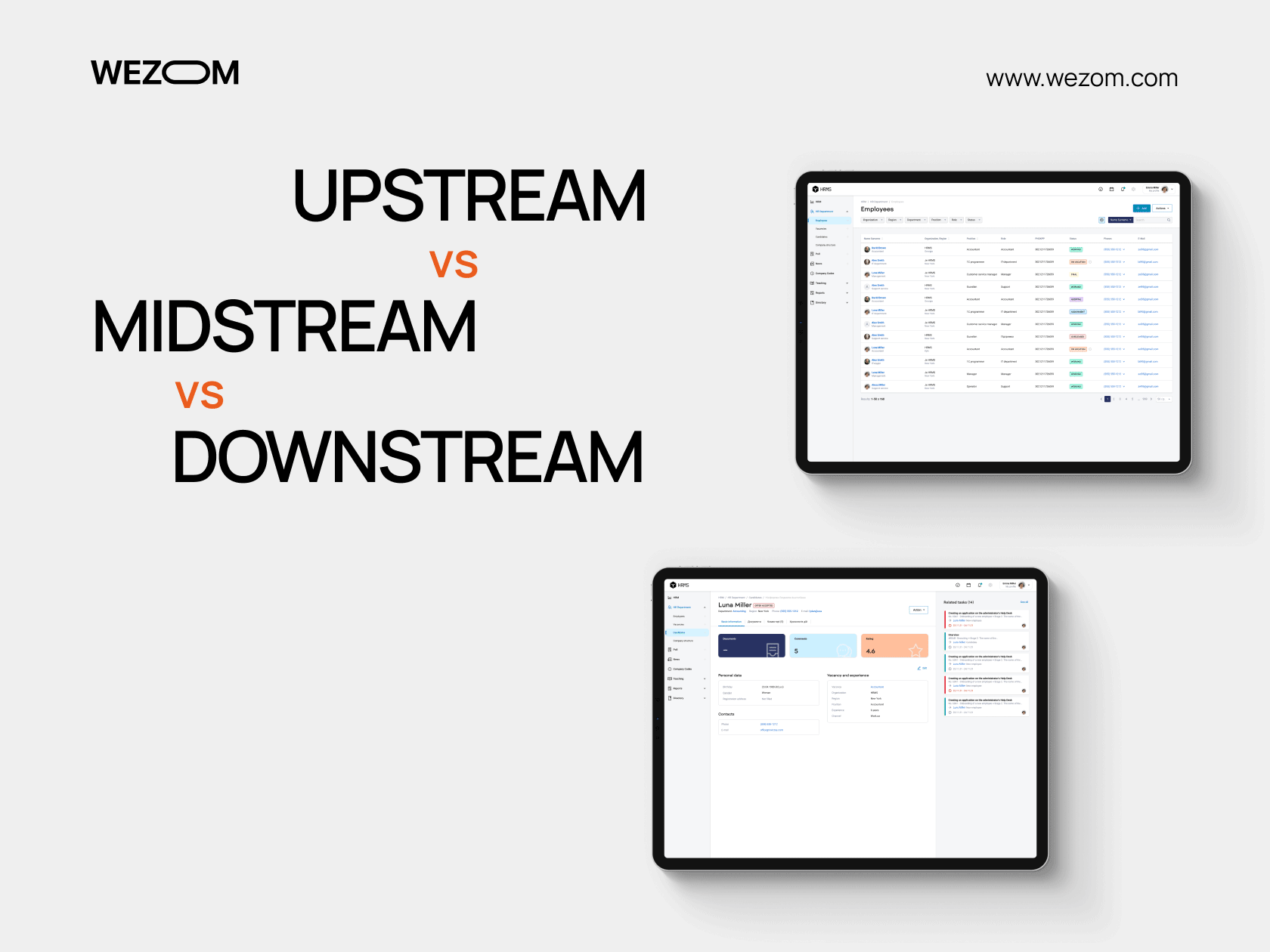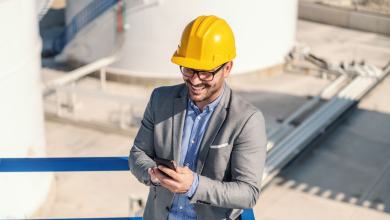In the ever-evolving landscape of software development and technology, it's crucial to understand the different stages of the software development lifecycle.
The terms “upstream”, “midstream”, and “downstream” draw an analogy to the flow of a river, where software progresses through various phases, much like water flowing from its source to its destination. Each phase has its own unique characteristics, challenges, and objectives, making it essential for developers, project managers, and stakeholders to grasp the distinctions between upstream, midstream, and downstream software development.
In this exploration, we will delve into these three key aspects of software development, shedding light on their roles, functions, and significance in the broader software development ecosystem.
The oil and gas industry has evolved from a time when oilmen used to drill in the field with their instincts and a chief with hand-scribbled notes. Today, intelligent process automation has made it possible for companies to become more efficient. Oil and gas accounting solutions are among the tools that are transforming the modern market.

Large or small companies use technology to automate where there was never before and improve the entire process. This is ideal for the oil and gas company. The oil and gas industry has always been an elemental part of the construction and economy. Regardless of which area you belong to, this industry is crucial for a smooth modern society. This sector is heavily influenced by government regulations, economic factors, and technological advancements.
Let’s have a look on these software types and the way they help companies grow.
Upstream vs. Midstream vs. Downstream: Key Difference
In the oil and gas industry, "upstream," "midstream," and "downstream'' refer to distinct sectors with unique software needs. Downstream vs upstream services has their own distinctive features:
- Upstream involves exploration and production, requiring software for subsurface modeling, drilling optimization, and real-time data analysis.
- Midstream focuses on transportation and storage, with software for pipeline management, asset tracking, and safety compliance.
- Downstream encompasses refining and distribution, needing software for process control, inventory management, and retail operations.
Advanced technologies like IoT and AI are being adopted across these sectors for efficiency and safety. Real-world examples, like WEZOM's transport learning and billing systems, demonstrate how technology is modernizing the industry.
WEZOM has relevant experience with cases of developing a transport learning management system for one of the leaders in the transport services market, as well as a platform for gamified online learning to speed up the educational process and automate internal routine. Also, the company has experience in creating enterprise billing systems that are tailored to the client’s needs.
Upstream Software
When it comes to knowing the difference between upstream vs downstream software, you can say that the upstream sector within the natural resources domain encompasses a wide spectrum of operations revolving around the exploration of oil and gas. It encompasses the full journey from the quest to discover new reservoirs of crude oil and natural gas to the intricate processes of extraction and refinement from underground reservoirs.
In recent years, the upstream software industry has undergone a profound transformation, largely catalyzed by remarkable technological advancements. These advancements have ushered in a new era of efficiency and productivity, revolutionizing the way the industry approaches its core activities.
Today, the upstream software sector has blossomed into a colossal market, with trillions of dollars circulating annually. Astonishingly, approximately $7 billion of this substantial sum is lost due to non-productive time spent on data evaluation and manipulation. This staggering figure underscores the critical need for innovation in data management within the upstream software domain.
Moreover, it's essential to note that many companies within this sector still grapple with limited data management capabilities. This glaring gap between potential and reality leaves ample room for growth and development. As the industry continues to evolve and adapt to new technologies, there is an unprecedented opportunity for upstream software solutions to enhance operational efficiency, reduce waste, and drive sustainable growth within the natural resources sector.

Midstream Software
In the world of oil and gas, the midstream segment operates like the lifeblood connecting the pumping heart of upstream drilling and the sprawling network of downstream refineries. It's the unsung hero, quietly processing, storing, and transporting crude oil and natural gas through vast pipelines that stretch for miles.
But amidst the steady flow, a shadow lurks - pipeline vandalism. Crafty thieves sometimes drill into these veins of energy, siphoning off valuable resources. This underbelly threat is where midstream software becomes the guardian, the watchful eye in the darkness.
Imagine a digital sentinel, tirelessly patrolling the pipelines, monitoring every inch for anomalies. It doesn't just keep count of the pipes and valves; it senses when something's amiss, when equipment goes missing, or when it's harmed. And it doesn't keep this secret to itself - it alerts you with a silent digital whisper, a phone call, or an email, so you can leap into action before the thieves even finish their caper.
But it's not just about thwarting theft. Midstream software ensures the safety of the environment, making sure the black gold doesn't spill and wreak havoc on the land. It also dances to the tune of regulations, ensuring that every move complies with the strict rules of the game.
In this digital age, it's a silent guardian of the pipelines, the protector of the flow, the keeper of the oil and gas lifeline. It's the unseen hero that keeps the world running, one alert at a time.
Downstream Software
Downstream stage includes all of the activities involved in turning crude oil and natural gas into various finished products that we need on a daily basis. Some of these products include gasoline, diesel, kerosene, jet fuels, heating oils, and asphalt.
Long-chain hydrocarbons present in both crude oil and natural gas are further utilized to manufacture less obvious products such as synthetic rubbers, preservatives, containers, and plastics for infinite products. Paints, dyes, and fibers manufacturing have some connections to oil and natural gasses. When it comes to upstream vs downstream flow, and businesses, downstream software helps monitor costs and boost performance; it also keeps an eye on incidents like spills or accidents.
Upstream vs Midstream vs Downstream: How They Are Benefited By Software Development
As upstream and downstream in oil and gas have their intricacies, software has differences, too. Software development now plays an important role not only as software is a powerful tool for reaching certain business goals, but also as it allows businesses to grow to new levels.

Here are certain benefits of software development that deserve particular attention:
Data Security
Data security is a crucial issue in all industries, and malicious attacks have surged in both state-run and private sectors. This is why businesses seek a safe solution to protect their sensitive data in various ways.
Personal Safety
The oil and gas industry focuses on the safety of its workers, especially when they are working with flammable materials. With automation, the industry can overcome this issue by using intelligent process automation and software development to design creative risk detection mechanisms such as real-time sensors and biometric scanners.
Efficiency
In the oil and gas industry, which involves so much movement of one currency, upstream and downstream software management allows to improvise and become more efficient in execution, thus saving time and material. Software applications in these sectors can collect information and store it in their repositories.
Drilling Assistance
Drilling is the most important task in the oil and gas industry, but acquiring the wrong techniques can lead to financial disasters. However, with the integration of artificial intelligence(AI) and sensor technology, one can improve drilling efficiency.
Chemical Analysis Processes
The oil and gas industry works with substances extracted from the environment, but these materials are not ready to be transported or marketed. The unwanted materials need to be removed from the main one, which is done via chemical analysis processes involving various separate tasks like extraction, laboratory tests, and obtaining certain parameters in order to achieve desired objectives.

Summary
In conclusion, the oil and gas industry has been undergoing a digital transformation for many years now. This has been made possible by the use of oil and gas accounting solutions tailored to upstream, midstream, and downstream operations. Differences between upstream midstream and downstream make the software choice more intricate.
The oil and gas industry is characterized by fierce competition and is constantly changing. The upstream segment is responsible for extraction and production, midstream involves safely transporting materials, and downstream involves transforming these resources into finished products.
These three segments together sustain the constant flow of fuels and materials that makes the life of employees better and safer. Accessing and analyzing capital from upstream, midstream, and downstream segments as well as linking oilfield data into useful information anywhere is crucial to remain ambitious as this sector keeps evolving.
These digital tools optimize processes, enhance safety, ensure regulatory compliance, and improve overall efficiency. As the industry continues to evolve, more advanced technologies such as data analytics, the Internet of Things (IoT), and automation will play a pivotal role in weaving a digital tapestry that connects and empowers every facet of the oil and gas sector.
Through these innovations, the industry can adapt and thrive while contributing to a sustainable energy future.
